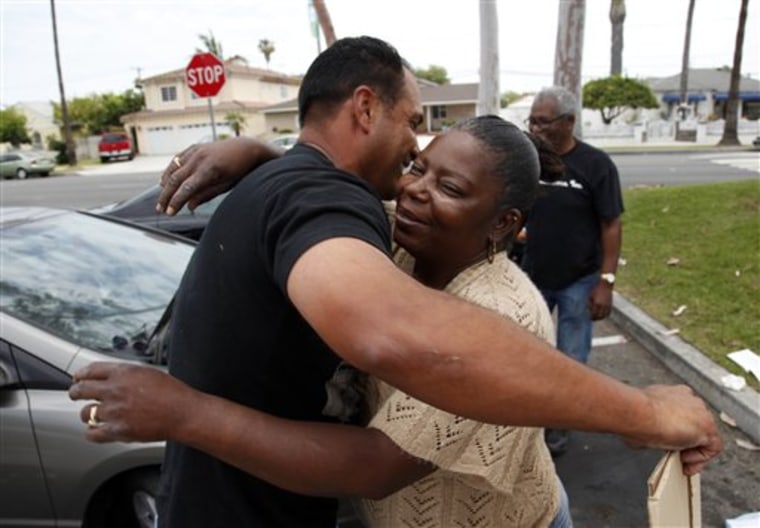Federal prosecutors called their sweeping indictment of the Varrio Hawaiian Gardens gang the biggest takedown of its kind in U.S. history.
That was sure to grab attention, but details buried in the court documents were bound to touch a raw nerve: One of the Latino gang's primary motivations was hatred of black residents.
It's the third time in recent years federal prosecutors have investigated a gang and found racism in its DNA, reopening a thorny debate that has publicly divided the region's top cops.
In dueling newspaper opinion pieces last year, Los Angeles County Sheriff Lee Baca maintained that race fueled gang violence while Los Angeles Police Chief William Bratton said skin color was seldom a factor.
"If you do a survey within the African-American community ... you are in constant fear that your young male offspring is going to be killed because of the color of his skin," Baca said in an interview after his piece appeared in the Los Angeles Times.
In an area both proud and sensitive about its diversity, racial tension has been at the heart of some of its ugliest chapters: from the zoot suit riot beatings of Latinos by white sailors in the 1940s to the deadly Watts riots in 1965 to the riots that erupted in 1992 after four police officers were acquitted in the videotaped beating of Rodney King.
So-called brown-on-black or black-on-brown violence has been a long-standing concern in neighborhoods where black residents are being supplanted by Latinos. Acknowledging it, however, has political implications and officials often downplay the tension.
"Saying gangs make targeted racial hits can add a great deal of fear of communities," said Joe Hicks, vice president of Community Advocates Inc. and former executive director of the city's Human Relations Commission. "We are not on the edge of some kind of racial Armageddon here. It's just part of the picture, but it's a particularly frightening part of it."
Baca, an elected official, says his opinion comes from running the county jail system where he has to segregate inmates because of gang affiliations that break along racial lines.
The race factor
Bratton works for a politically appointed commission and the Los Angeles Police Department has traditionally dealt with black gangs more than Latino gangs, though that is rapidly changing.
"Is there racial crime committed by gang members? Yes, of course," said Deputy Police Chief Charlie Beck, head of detectives under Bratton. "But if you are asking me if race is a primary factor in gang crime, the answer is no."
Having worked as a Boston cop in the 1970s when different races were bused between schools in an attempt at forced integration, Bratton is keen not to stoke racial fears, said Constance L. Rice, director of the Advancement Project, which studies gang violence.
"He comes out of some terrifying policing situations," she said. "He knows what happens when you don't handle this stuff right."
While U.S. Attorney Thomas O'Brien would not comment about the debate between the two, he said his office calls cases as it sees them.
"I am not concerned about political backlash for anything," O'Brien said.
Crimes of hate
The indictment of 147 alleged Varrio Hawaiian Gardens members and associates on charges ranging from racketeering to kidnapping and attempted murder marks the third time O'Brien's office has said explicit racial hatred plays a major role in gang crime.
Most gangs are formed along racial or ethnic lines, so turf battles can easily be construed as racist, though they're usually driven by desire to control lucrative drug territory or other gang business.
"Every time you see one case, it's easy to blow it up into a hate crime," said Malcolm Klein, a University of Southern California social psychologist. "I tend to downplay that."
But the cases federal prosecutors have brought often have involved innocent victims who don't belong to rival gangs. The Varrio Hawaiian Gardens investigation began after a gang member killed a sheriff's deputy.
Violence goes both ways
In 2005, federal prosecutors indicted members of The Avenues, a Highland Park gang, charging them with hate crimes for killing a black man in what prosecutors called a campaign to drive blacks from that neighborhood.
Two years later, another indictment charged dozens of members of the Florencia 13 gang in south Los Angeles, saying the gang had killed black people because of the color of their skin.
The violence goes both ways, with the Grape Street Crips, a black gang, trying to force Latino residents out of a housing project in the Watts area of south Los Angeles.
Baca and Bratton's diverging views surfaced after the U.S. attorney unveiled the racketeering indictment against Florencia 13. The debate intensified when Jamiel Shaw, a black high school football player, was killed by a man prosecutors say is an illegal Mexican immigrant.
Anti-immigrant sentiment
Much of the true racially motivated violence stems from directives from prison gangs, said Robin Toma, executive director of the Los Angeles County Human Relations Commission.
The Varrio Hawaiian Gardens and Florencia gangs took orders from higher-ups in the Mexican Mafia, a prison-based gang known to be highly racial.
Pinning gang crime on race can prompt a backlash from community members.
"That's the real danger," Toma said. "It's difficult to keep a lid on this stuff when people are getting shot."
